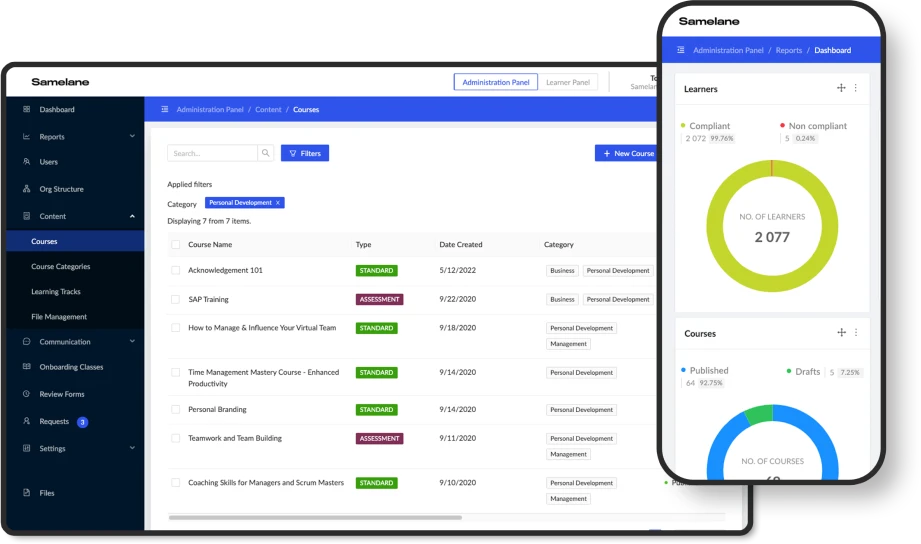According to Gartner, 77% of chief learning and development officers are taking an insufficient approach to reskilling their workforce. In one of its latest studies, “Reskilling the workforce. What works better – building continuous learners or building connected learners?” Gartner argues that connected learning approaches outperform continuous learning methods.
According to Gartner’s experts, connected learning enables organizations to develop a workforce that is better equipped with the skills needed for achieving business success. Moreover, they emphasize that connected learning responds more effectively than continuous learning to organizational needs and employee goals and enables people to experience development that has practical applications.
The authors add that connected learners are better positioned for their current roles and future careers, and their motivation increases by 39%. Let’s take into account the conclusions of the Gartner study and examine in what aspects building connected learners is superior to continuous learning.
Read also: The Journey from Conventional to Agile Learning: A Step-by-Step Guide
Continuous Learners vs Connected Learners
Out of necessity, let us recall the most widely used definitions of both title approaches to training.
Continuous learning refers to an ongoing process where employees consistently seek to acquire new skills and knowledge to enhance their performance and adapt to changes in the workplace. This approach emphasizes lifelong learning and the continuous improvement of professional abilities.
In connected learning, the learner pursues professional interests using technology to have the fullest possible training experience. In connected learning, corporate training is focused on opportunity and recognition. Learning support platforms such as learning management systems (LMS) that have open network infrastructure are of great importance here. As members of the Connected Learners Alliance explain to us, this method connects personal interests to meaningful relationships and real-world opportunities.
Connected learning integrates personal interests, supportive relationships, and access to opportunities. In the era of multiplicity of information and social connections, connected learning grows from people’s diverse interests and resources (definition from Connected Learning Alliance).
1: Identifying the Right Skills to Develop
Gartner looked closely at three essential HR tasks: identifying the right skills to develop,
motivate employees, and deliver effective learning solutions. Then, the authors compared how two L&D strategies approach the task: building continuous learners and building connected learners.
In the first task, continuous learning advises that L&D managers in the organization work closely with the business to keep up with the skills that leaders request. This approach intends to help them identify the right employees’ skills to develop.
However, it falls short as it relies on individual leaders’ perspectives. It misses a broader market view of skills that are in demand. Moreover, employees are disconnected from the market skills required for success in this strategy approach to identifying the right skills to develop. As Gartner shows, it also negatively impacts (20%) on identifying needed skills.
How does the Building Connected Learners strategy approach this task? Its approach can be described as market-driven and predictive. It uncovers the most pressing skill needs for employees. This approach seems better than continuous learning as it demonstrates high relevance and comprehensive and connects learners to in-demand market skills. Moreover, according to Gartner’s report, connected learners are 8x more likely to be high performers.

2: Motivate Employees
Another task wherein the study’s authors compared two strategic approaches to employee learning is motivating employees.
The Building Continuous Learners approach advises employees to regularly communicate the shifting skills required for organizational success to encourage them to upskill when and where needed.
Is continuous learning less effective than connected learning in motivating employees? The authors caution that this strategy has significant drawbacks as it pushes organizational agenda but misses employee context. In this type of learning cultures, employees’ personal needs are disconnected from the organization’s needs.
In contrast, the Building Connected Learners strategy proposes to demonstrate to employees the personal benefits of upskilling and show them how they can grow personally. As the study’s authors argue, this approach combines employee context with organizational benefit and makes the organization’s goals personal. The pace of employee learning is accelerated by as much as 25%.
Read also: What is refresher training, and how can it benefit your organization?
3: Deliver Effective Learning Solutions
In the case of delivering effective learning solutions, building continuous learners involves providing ongoing self-service development options. This way, employees can access effective development opportunities when they need them. However, this organization approach also means unfocused learning opportunities and overwhelmed employees. Gartner adds that employees are disconnected from the skill development opportunities they need.
Building Connected Learners, in turn, connects employees to skill-building opportunities beyond their roles and brokers specific development experiences. The result is higher employee engagement, which results in higher intent to stay. The study’s authors support this with data, according to which connected learners are 66% more engaged and 4.2x more likely to stay with the company.
Is continuous learning less effective than connected learning in motivating employees?
| Continuous Learning | Connected Learning | |
| Identifying the Right Skills to Develop | working closely with the business to keep up with the skills that leaders request | a market-driven and predictive approach that uncovers the most pressing skill needs of employees |
| Motivate Employees | regularly communicating the shifting skills required for organizational success to encourage them to upskill when and where needed. | demonstrating to employees the personal benefits of upskilling and showing them how they can personally grow |
| Deliver Effective Learning Solutions | An ongoing self-service development | connecting employees to skill-building opportunities beyond their roles for specific development experiences |
This shortcut of the approach of both methods allows us to assess whether continuous learning is less effective than connected learning.
Concluding the insights
The future of work is constantly changing. Changes include the impact of the gig economy (freelancing and working for multiple companies, most often remotely), an aging workforce, and the rapid adoption of artificial intelligence. In this reality, organizations prioritizing developing connected learners can gain a key competitive advantage.
Gartner argues that assessing your learners responds more effectively to organizational needs and employee goals. In addition, this strategy intends to equip the organization’s employees with the market skills required for success and provide meaningful development experiences.
Do you want to implement modern connected learning in your organization? Try Samelane LMS and discover all its amazing features!











